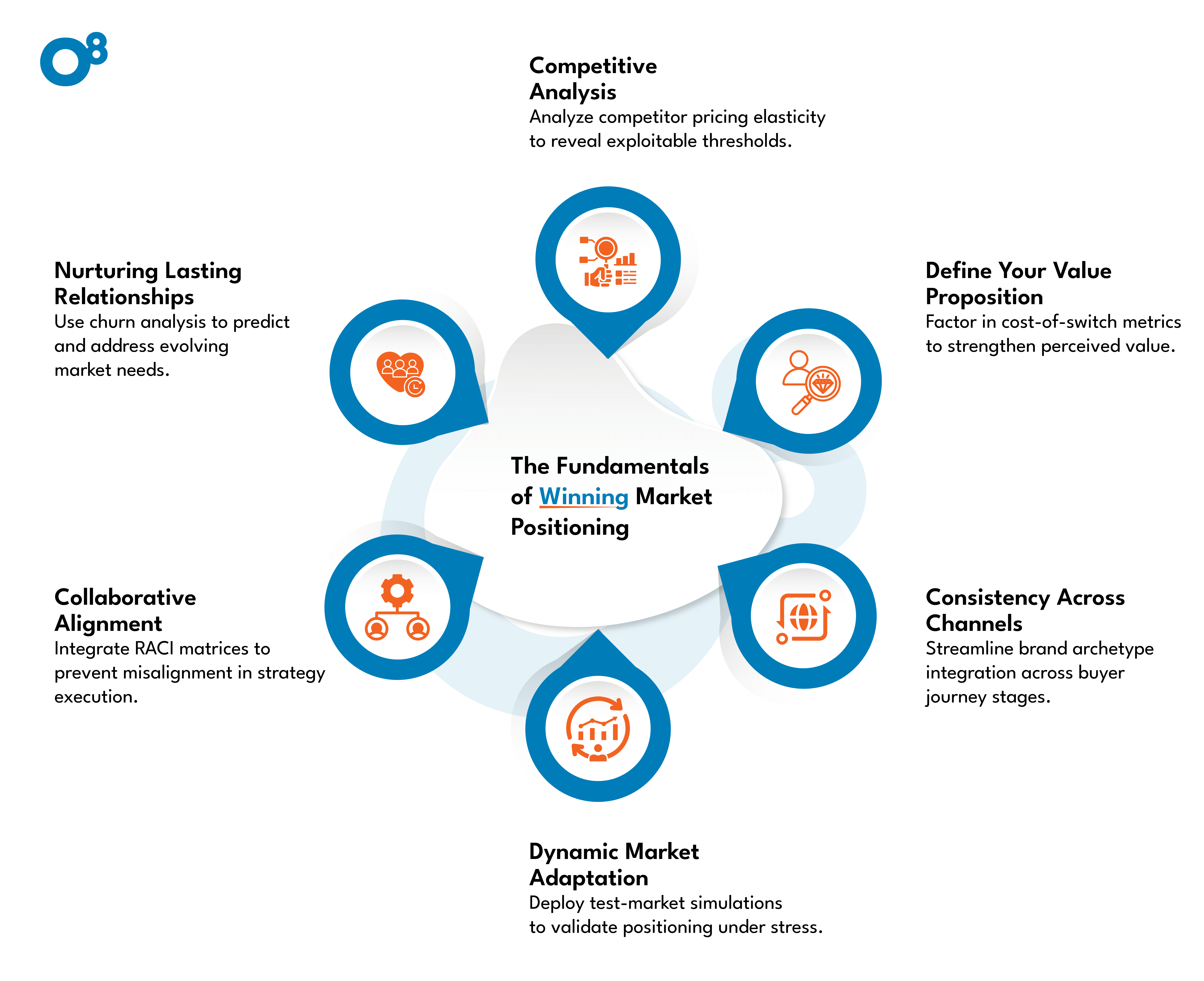Unlocking Market Success: The Ultimate Guide to Market Positioning Strategy for Revenue Growth

- Conduct a competitive analysis to identify market gaps that your brand can fill.
- Define a unique value proposition to articulate why your target market should choose your brand over competitors.
- Ensure consistent communication of your brand's value across all channels for a coherent brand narrative.
- Utilize market research to tailor your positioning strategy to resonate with your target market.
- Engage cross-functional teams to enhance alignment and effectiveness of your positioning strategy.
Market positioning strategy is the process of defining where your brand fits in the marketplace. It’s not simply about having a catchy slogan or an eye-catching logo, but about aligning your brand's core values with those of your target audience. This strategy helps businesses stand out by finding that perfect spot in the market ecosystem. When done effectively, it can significantly boost both revenue and customer loyalty.
Remarkably, 87% of customers choose brands that share their beliefs, underscoring the importance of aligning brand values with consumer expectations.
However, executing a market positioning strategy comes with its challenges, including:
- Navigating the competitive landscape while maintaining a unique voice
- Crafting a positioning statement that resonates with your audience
- Consistently communicating your positioning strategy across all channels
Addressing these challenges is crucial for positioning your brand as a leader in your field. By understanding and tackling these issues head-on, you can create a strategy that not only enhances your brand's visibility but also strengthens customer relationships. Let's explore practical steps and insights to effectively position your brand and outshine your competition.
Understanding Market Positioning

Market positioning is a fundamental aspect of any successful brand strategy. It's about carving out a distinct space for your brand in the minds of your target audience, making sure you stand out from your competitors. This strategy involves understanding not just the needs and desires of your audience but also how your brand can uniquely fulfill them.
The significance of effective market positioning cannot be overstated. According to statistics, consistently positioned brands generate, on average, 10-20% more revenue. This highlights the financial impact of ensuring your brand is clearly defined and communicated across all platforms.
To master market positioning, businesses must address several key areas:
- Competitive Analysis: Understand who your competitors are and what they offer. This knowledge helps in identifying gaps your brand can fill.
- Define Your Unique Value Proposition: Clearly articulate what makes your brand unique and why your target market should choose you over the competition.
- Tailor Your Messaging: Consistently communicate your brand's value and position through all marketing channels to maintain a coherent brand narrative.
By focusing on these elements, your brand can achieve a strong market position that resonates with your audience and drives long-term success.

How to Develop an Effective Market Positioning Strategy

Developing a market positioning strategy requires a thoughtful process, beginning with a detailed competitive analysis. By examining the offerings and strategies of your competitors, you can identify gaps that your brand can fill. This approach was successfully leveraged by The Sill, which set itself apart by providing urban customers easy access to houseplants, coupled with education and community engagement, distinguishing itself from conventional plant retailers.
Once you've identified your niche, the next step is to articulate a clear and compelling value proposition. This encapsulates why your product or service is the ideal choice for your target market. For instance, in the R3 Continuum case study, the focus on unique behavioral health solutions was pivotal in enhancing lead generation and conversion rates.
After establishing your value proposition, ensure your messaging is consistent across all channels to maintain a coherent brand narrative. April Dunford, a respected authority on product positioning, emphasizes a dynamic and strategic approach that involves continuous market adaptation. Incorporating cross-functional teams in this process further strengthens alignment and ensures that your brand's message resonates with your audience.
By following these strategies, you can craft a market positioning strategy that not only differentiates your brand but also fosters lasting customer relationships.
Power up your brand and dominate your market with O8
Let’s define your unique position—together.
The Key Components of a Positioning Statement: Insights from April Dunford
April Dunford, a renowned expert on product positioning, offers valuable insights into crafting an effective positioning statement. She defines positioning as the process of establishing how a product uniquely meets the needs of a specific customer segment, distinguishing it from competitors.
According to Dunford, there are five crucial components of a positioning statement:
- Competitive Alternatives: This involves understanding the other options customers might consider and how your product stands out.
- Differentiated Features or Capabilities: Highlighting what sets your product apart from the competition.
- Value for Customers: Clarifying the benefits the product delivers and the outcomes it promises.
- Target Customer Segmentation: Defining the specific group of customers who will find the most value in your product.
- Market Category: Determining the market context in which your product operates.
Dunford advises against relying solely on traditional positioning statements, which often oversimplify the process and fail to fully capture a product's unique value. Instead, she recommends a comprehensive approach that includes:
- Identifying Unique Strengths: Recognize the distinct features and capabilities of your product.
- Articulating Customer Value: Translate these features into clear benefits for your customers.
- Targeting the Right Customers: Focus on those customers who will derive the most value from your product.
Dunford also emphasizes that positioning is not a one-time task but an ongoing process that should evolve with market changes and customer feedback. She highlights the importance of involving cross-functional teams, including leadership, in the positioning process to ensure alignment and effectiveness.
In summary, Dunford advocates for a strategic and dynamic approach to positioning, focusing on unique differentiation, clear customer value, and continuous adaptation to maintain a competitive edge.
Conducting Market Research for Positioning

Market research is a cornerstone of effective positioning. It provides the insights needed to understand your target market, identify competitive alternatives, and pinpoint your unique value proposition. Without comprehensive market research, your positioning efforts may miss the mark, failing to resonate with your ideal customers or differentiate you from your competitors.
Here are some practical steps to conduct effective market research for positioning:
- Define Your Target Audience: Identify the demographic, psychographic, and behavioral traits of your ideal customer. Understanding their needs, preferences, and pain points can help you tailor your offering and messaging to resonate with them.
- Analyze Your Competitors: Understand who your direct and indirect competitors are, what they offer, and how they position themselves. This can help you identify gaps in the market that you can fill and differentiate your brand.
- Understand Your Industry: Stay updated on industry trends, changes, and forecasts. This can help you adapt your positioning strategy to align with market dynamics.
- Gather Customer Feedback: Regularly collect feedback from your customers through surveys, interviews, and social media interactions. This can provide valuable insights into how your brand is perceived and how you can improve your positioning.
- Test Your Positioning: Once you've developed your positioning strategy, test it with a small segment of your target market to gauge its effectiveness. This can help you refine your positioning before rolling it out on a larger scale.
By conducting thorough market research, you can create a positioning strategy that accurately reflects your brand's unique value and resonates with your target market. As customer-centric cultures experience a 21% higher profitability, positioning your brand to align with your customers' needs is a strategic move towards business success.
Communicating Your Positioning Strategy

Effectively communicating your positioning strategy is key to connecting with your target audience and differentiating your brand in the marketplace. Here are some strategies to ensure your messaging aligns with your audience's needs and consistently conveys your brand's unique value proposition:
- Align Messaging with Audience Needs: Start by understanding your target audience's core needs and desires. Crafting messages that address their specific interests and challenges allows you to resonate deeply with them, creating a unified brand narrative.
- Consistency Across Channels: Ensure your messaging is uniform across all channels, from digital marketing efforts to in-store experiences. A case in point is Wizeline, a global technology services provider, which O8 helped to successfully maintain a clear and consistent message across all marketing platforms.
- Multi-Channel Strategy: Leverage a variety of platforms to reach customers where they are. Employ social media, email campaigns, and content marketing to reinforce your brand's position. According to a Harvard Business Review study, companies with a strong multi-channel brand message enjoy a 33% higher customer retention rate, highlighting the importance of consistent communication.
- Engage Cross-Functional Teams: Involve various team members in the communication process to ensure alignment and authenticity in your brand's messaging. This collaborative approach enhances the effectiveness of your strategy and builds stronger audience connections.
By embedding these strategies in your communication efforts, your brand can effectively convey its positioning and foster lasting relationships with your audience.
Frequently Asked Questions about Market Positioning
What is Market Positioning?
Market positioning is a strategic approach that involves defining how your product or service is unique and why it is the best choice for your target audience. It's about carving out a distinct space in the market, differentiating your brand from competitors, and resonating with your customers' needs and values.
Why is Market Positioning Important?
Market positioning is crucial because it helps your brand stand out in a crowded marketplace. It enables you to align your product or service with your target audience's needs, creating a strong brand identity that can drive customer loyalty and business growth.
How to Develop a Market Positioning Strategy?
Developing a market positioning strategy involves understanding your target audience, analyzing your competitors, defining your unique value proposition, and consistently communicating this positioning across all marketing channels. It is also essential to test and refine your positioning based on customer feedback and market changes.
What Are the Key Components of a Positioning Statement?
A positioning statement typically includes your target audience, the market category you operate in, your unique selling proposition, and the key benefits your product or service offers. It succinctly defines your brand's unique value and how it fulfills your target audience's needs.
How to Conduct Market Research for Positioning?
Market research for positioning involves defining your target audience, analyzing your competitors, understanding industry trends, gathering customer feedback, and testing your positioning. These insights can help tailor your positioning strategy to resonate with your target market and differentiate your brand.
Wrapping Up: The Power of Effective Market Positioning
As we've explored in this guide, effective market positioning is a critical component of a successful branding strategy. It's about understanding your audience, recognizing your unique value, and communicating your brand's position consistently and compellingly.
When executed well, positioning can differentiate your brand in the marketplace, resonate deeply with your target audience, and drive business growth. It's not just about standing out—it's about connecting with your audience in a meaningful and authentic way.
Remember the words of April Dunford, who emphasized that positioning is not a one-time task but an ongoing process that needs to evolve with market changes and customer feedback. Continually refining your positioning can ensure it remains relevant, powerful, and effective.
By leveraging the power of market positioning, you can build a strong brand identity, foster customer loyalty, and steer your business towards long-term success.
Ready to position your brand for success?
Partner with us at O8 to create a brand identity that resonates with your audience and drives growth!








